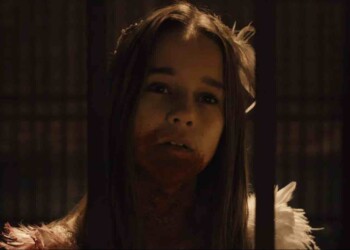In the latest ‘Send the Ravens’, we answer your ‘Game of Thrones’ questions about the Night King, Arya’s role in the battle and much more…
By Damon Martin — Editor/Lead Writer
The Battle of Winterfell has now come and gone as the living defeated the Army of the Dead over the course of 82 minutes.
It was one of the most highly anticipated episodes of television in recent history and while the majority of the reactions have been positive, there have definitely been a few complaints as well. I’m not going to address the cinematography and the issues with the darkness of the episode but rather this will just be about the story itself that unfolded in third installment of the final season.
There were a lot of questions about this particular episode but the one asked repeatedly — in a similar form or fashion — was the way the Night King came and went in a single episode after he was destroyed by a Valyrian steel dagger courtesy of Arya Stark.
Now first things first when we discuss the Night King it must be disclosed that this version is completely unique to the television series (at least so far anyways).
In the books, the Night’s King — according to legend — was the 13th Lord Commander of the Night’s Watch, who fell in love with a ‘sorceress pale as a corpse’ who later declared himself king. This Night’s King was rumored to rule during a period of darkness for the next 13 years alongside his ‘corpse queen’ until Brandon the Breaker and the first ‘King-Beyond-the-Wall’ Joramun brought him down.
The legend says that Brandon the Breaker —a member of the Stark family and former Lord of Winterfell — banished all mention of the Night’s King from any records, which is why his true name has never been known. Rumors say that Brandon eliminated the Night’s King true identity because he was a member of the Stark family.
The description of the Night’s King’s bride led many to believe that she was a White Walker, who he fell in love with and later married. The two of them then led a reign of terror for 13 years until they were finally stopped.
The Night’s King has been mentioned a couple of times in the books including a story told to Bran Stark by Old Nan as well as Samwell Tarly when speaking about these supposed legends who have their legitimacy questioned by the archmaesters at the Citadel.
When the Night King first appeared on ‘Game of Thrones’, just about everybody — including me — thought this might be confirmation of the character’s existence in the books. That said, George R.R. Martin has never gone as far as actually exploring the Night’s King or the Night King as an actual character in his books so it’s possible he appears in the future but as of now there is no such leader of the White Walkers in the source material.
So it’s safe to assume that the showrunners behind the ‘Game of Thrones’ series took some liberties when crafting the Night King, especially when it came to his creation as we saw a few seasons ago when it was revealed that he was made as a weapon by the Children of the Forest in their war against the First Men invading Westeros. They made him as a weapon but the Night King spiraled out of control because he was literally death incarnate and his only mission was to kill the living — everything that was living — and it forced the Children of the Forrest and the First Men to eventually team up to stop him.
The second most asked question this week was regarding the Night King surviving the dragon fire attack from Daenerys yet he was later killed by a single stab from a Valyrian steel blade. Why did one kill him and the other didn’t?
Well this is all a working theory but here’s what I can explain…
As far as the Night King surviving dragon fire, that may simply be a power that he possesses, potentially alongside the White Walkers themselves. We saw Daenerys roast a ton of the wights when she went north of the Wall to rescue Jon Snow and his scavenging party last season but none of the White Walkers were touched. It’s possible that this is the balance between ice and fire and they cannot be burnt by flames.
There have been several questions about the Night King possibly being a Targaryen, which like Daenerys could prevent him from being burned by fire. While there’s a slim possibility that the Night King comes from Valyria (where the Targaryens originated) — the once mighty city in Essos where dragons were first bred for war — it seems somewhat unlikely.
Valyrians were not only dragonlords but they were also deep into some very dark magic, usually involving blood or fire. The problem is the Valyrian Freehold didn’t exist during the period of time when the Night King would have been created. Based on the version in the show, the person captured and later transformed into the Night King by the Children of the Forest was just a random person they took captive and then used him in their war against the First Men.
When it comes to Valyrian steel and/or dragonglass killing White Walkers or in this case the Night King, there is a possible explanation.
While it’s been noted numerous times that Valyrian steel was forged by dragon fire, that’s never actually been documented.
What we do know about Valyrian steel is that it was meticulously crafted by the Valyrians, who also put magic spells on the metal as they were forging it into weapons. George R.R. Martin has mentioned Valyrian steel being forged by dragon’s fire but based on what’s been written in the books, it would appear that at least part of the metal used to make Valyrian steel came from volcanoes. Dragonglass is also made from volcanoes.
Remember in the series, the Night King was created when the Children of the Forest cast a spell and then shoved a shard of dragonglass into his heart. It’s possible that the thing that made him can also unmake him and because both dragonglass and Valyrian steel are forged from volcanoes, that’s why Arya’s dagger was able to kill him.
With that said, let’s get to your ‘Game of Thrones’ questions for this week…
Hey @DamonMartin … was Arya dressed as one of the night king’s guard? The one who turned to the side when the night king was reaching for his sword to kill Bran.. ????????♂️
— joeboy™ ???????? (@pkdtmy) April 29, 2019
Tough to say without more footage of how Arya managed to creep into the Godswood and then leap at the Night King with her dagger in hand. Obviously, the Stark children know Winterfell better than anyone so it’s possible she knew some kind of secret entrance to get into the Godswood without being detected. Arya is also a master assassin trained in being very stealthy so that’s also a possible explanation.
While Arya can wear the faces of the dead we’ve never actually seen a White Walker killed who didn’t just shatter into a million pieces of glass. So the chances that Arya was disguised as a White Walker to sneak into the Godswood before killing the Night King seems unlikely.
Did we also witness the end of the Dothraki line? Dany had all of the men at her side as cavalry didn't she?
— Teufel Hunden Design Company (@THDesignCo) April 29, 2019
Jon Snow has done a lot of good things during his time on ‘Game of Thrones’ but if there’s one thing abundantly clear, he’s not exactly the best strategist when it comes to war. It seems that ability was passed onto his brother (or actually cousin) Robb Stark, who was a master strategist and strong leader but had a real problem with making really poor choices when it came time to live up to honor-bound pledges to marry one of Walder Frey’s daughters.
Jon doesn’t have the best record when it comes to his own battle plans working out — he failed miserably at the ‘Battle of the Bastards’ and the ‘Battle of Winterfell’ but he did put a good plan in place when defending the Wall from the Wildling army led by Mance Rayder. Then again Jon only stopped them for one night and if not for Stannis Baratheon showing up, he may have lost again.
Anyways…
Taking a look at Jon’s battle plans for the Battle of Winterfell, he didn’t seem to learn much from his past mistakes. He put all of the Dothraki at the head of the battle — in front of the trenches that were meant to be lit on fire to serve as a deterrent to the dead.
As cool as it was to see Melisandre stroll in and light all of the Dothraki arakh’s on fire, they were just as quickly destroyed after charging forward and meeting the Army of the Dead head on.
So by all accounts outside of a few stragglers that managed to escape it would appear that the Dothraki have been eliminated or at least their numbers have greatly dwindled after that battle.
Considering the lopsided advantage that Daenerys had over Cersei Lannister when they first met a season ago, it appears the Battle of Winterfell just evened up the odds a bit.
Is Aria Stark Azor Ahai?
— CJ Shallies (@cj234905) May 1, 2019
Just for a quick recap — Azor Ahai was the legendary warrior who supposedly helped put an end to ‘The Long Night’ after he forged a sword called ‘Lightbringer’ by stabbing the woman he loved death with it, which then set the blade on fire. Azor Ahai was supposedly responsible for helping to drive back the White Walkers during their first invasion and putting an end to the longest winter in recorded history.
The legends about Azor Ahai are many but the most popular prophecy surrounding him is the one called ‘the prince that was promised’.
That one goes like this — ‘the prince that was promised will bring the dawn’.
We heard Melisandre mention this to Daenerys a season ago when she arrived at Dragonstone and told her to summon Jon Snow because she believed they would both play a part in the war to come.
Now the books go a lot deeper with the whole ‘prince that was promised’ prophecy.
A lot of it traces to the Targaryen bloodline including additional prophecies that said the prince that was promised would come from a child born from Aerys II Targaryen and his wife Rhaella, which then led their son Rhaegar Targaryen into believing he was the prince that was promised. Rhaegar then passed along that prophecy to his son Aegon, who he then believed as that same prince that was promised.
Long story short, none of that has even been mentioned in ‘Game of Thrones’ so it’s possible they won’t ever bring it up again.
What we do know is that Melisandre specifically mentioned ‘the prince (or princess) who was promised’ a season ago when speaking to Daenerys while adding that prophecies are tricky things. She couldn’t say for certain if this prophecy related to Jon Snow or Daenerys or possibly someone else.
Melisandre did know from her earlier prophecy regarding Arya Stark that she would end the lives of people with brown eyes, green eyes and blue eyes, which was the key to sending her out to kill the Night King.
It’s entirely possible that this ‘prince who was promised’ prophecy related to both Jon and Daenerys as Targaryens because even though they didn’t kill the Night King, they were both huge parts of the preparation for the war to stop him. For the longest time, Jon Snow was the only person convinced that the war with the Army of the Dead was looming and measures had to be taken to prepare for their arrival.
The second prophecy that Melisandre saw when she first met Arya could have then meant she was the person who would go onto kill the Night King but striking that single blow doesn’t necessarily make her the ‘prince who was promised’.
Unfortunately the key to all of this may have been Melisandre and she’s already dead so it’s not likely we’re going to find out much more from her. It’s tough to say at this point if the ‘prince who was promised’ will ever be mentioned again now that the war against the Night King is finished.
https://twitter.com/cplcast/status/1123388643794505729
Yes those were the skeletons of the long dead Starks, who broke out of their crypts to attack the living. It seems they only rose from the dead after the Night King was on the ground and he put his hands up to raise all off the fallen soldiers who had just died in battle.
This is just a working theory but the Night King’s power of resurrection could be related to where he’s standing when he raises his hands. Back at Hardhome, the dead widlings killed in battle didn’t just get up and start walking around immediately. Instead it was after the Night King put his arms in the air that they began springing back to life.
Perhaps Starks in those crypts only became reanimated because the Night King was nearby and when he raises his arms to bring back the dead, he brings back everybody.
This is probably an easy question for you, but who was Bran controlling that whole time?
— Jason (@JasonAmadi) April 30, 2019
Well we know that Bran was controlling a pack of ravens that were flying overhead during the battle after he told Theon that he was leaving. Those ravens didn’t really do much, at least not that we saw, so is it possible that Bran was warging into some other animal or even person during the battle?
It could be anything honestly but what we know for certain is that Bran was controlling those ravens. Beyond that it’s just speculation.
Even though Bran’s job appears to be finished now that the Night King has been defeated, something tells me he still has a role to play in the war to come. The conversation that Bran had with Tyrion during the second episode after the war council ended will almost certainly come back into play in some way this season.
Considering how Tyrion was so depressed after failing Daenerys repeatedly, it would seem rather fitting that he would redeem himself before this season was over and Bran’s abilities as the Three-Eyed Raven may play a part in that.
‘Game of Thrones’ returns this Sunday night on HBO and don’t forget to submit your questions after the episode for the next edition of ‘Send the Ravens’.






